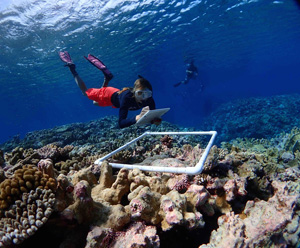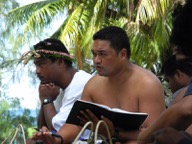For the remote Ulithi Atoll in Micronesia, it was the perfect storm.
First came the arrival of the U.S. Navy during World War II, bringing hundreds of ships, thousands of men, bulldozers that scoured runways through taro patches, and landing barges that scraped angrily over delicate coral reefs.
Then it was the importation of rice and Spam to supplement the taro fields and fishing that were lost. Along with that came cash payments so the people who’d once fished with canoes now bought motorboats, nets, and freezers, leaving behind their old ways of catching fish.
Climate change and ocean acidification arrived next so that, by the first decade of the 21st century, those who lived on the atoll not only noticed an alarming decline in their fish catch but also a rise in hypertension and diabetes.
Thanks to help from a dedicated group of scientists, led by UC Santa Cruz Professor of Ecology and Evolutionary Biology Giacomo Bernardi and his wife, Cabrillo College Biology Professor Nicole Crane (College Eight ’86, biology), the fish and traditions that, for centuries, sustained the ecological health of the islands — and the islanders — are now coming back.
“This is the real deal,” Bernardi says of the five-year conservation effort dubbed “One People One Reef.” “These people are protecting their reefs in order that they can live.”
Along with four other scientist-friends, Bernardi and Crane arrived on the largest of the atoll’s islands, Falalop, in 2010 after days of travel that only the most Zen-like voyager could survive. They came at the invitation of islanders, armed with years of scientific knowledge, some basic equipment — and their kids.
The scientists enlisted the help of John Rulmal Jr. who lived on Falalop and who introduced them to the ins and outs of Ulithi culture — including the specific roles of men and women, and governance by local chiefs.
They dove on the reefs to record coral health and count fish. They talked with residents, watched their kids play with island children, and sweated for hours in the men’s meetinghouse as stories slowly emerged about old fishing traditions and the severity of problems the 1,000 or so people on the island faced.
What they did not do was to come up with some amazing, Western-based management plan. Instead, they simply reported what they found.
They explained to islanders how using motorboats, spear guns, and nets caused the depletion of certain fish, which was unhealthy for the ecology of the area. They noted how the high cost of fuel had concentrated fishing in a few areas and pointed to poor sewage treatment that allowed organic waste onto the reefs and encouraged the growth of algae. They described how certain fish were good for the reef and talked about how old traditions had kept the fishery in balance.
For instance, Crane says, tradition used to dictate that some reefs were closed at the death of a chief or an important person on the islands and that others were shut down during certain times of year. Complex rituals had also slowed fishing. For instance, the killing of a sea turtle used to require a blessing from a certain chief on a certain island. The long trip often gave turtle harvesters second thoughts.
Bernardi, Crane, and Rulmal enlisted women, who traditionally cleaned the fish the men caught, to help scientists measure and sex the day’s catch and keep records of what was taken. They laid out their findings about the health of the reef.
Then they left.
“We said (to the islanders): ‘We don’t want to tell you what to do. These are your islands, your reefs,'” Bernardi says. “'We are just going to tell you what we see.'”
When Bernardi and Crane came back a year later, the chief — after hours-long meetings with island residents — had set up a system of reef closures, which was already beginning to show an increase in fish populations.
“All we were doing was reviving tradition,” Crane says. “These people have been managing these reefs for thousands of years. It was the recent changes that had caused problems: changes in fishing technique, cultural changes, loss of traditional leadership, and the advent of money…All we did was reconnect them to traditional management which had always been very effective.”
Soon word got out and other islands in the atoll requested the scientists’ help. Since then, Bernardi and Crane have come back year after year, bringing other scientists and, once, a doctor to talk about nutrition and health.
While scientific data are still being collected in order to judge the effectiveness of the change, the islanders are now reporting an increase in the amount and type of fish they are catching, according to Crane.
Bernardi said proof of the effectiveness of the islanders’ plan came in 2015 when super typhoon Maysak hit Ulithi head-on. Homes were washed into the sea, thousands of coconut trees were turned into stumps, and islanders lost their possessions. The chiefs opened the reserved fishing areas “and there were fish and that is what saved them,” Bernardi says.
The One People One Reef project, started with a $44,000 UC Pacific Rim grant, has now won more funding, including the National Oceanic and Atmospheric Administration’s Saltonstall-Kennedy award and a National Science Foundation grant. Recently, the program was selected as one of 15 semi-finalists out of 420 entries for the Buckminster Fuller Institute’s Fuller Challenge award.
As for the future, Crane sees the islanders “dancing a fine line between traditional cultural practices and the modern world.
“I don’t think it’s reasonable to suggest they throw away their ties to Western culture and revert back to only traditional ways. I see, in the future, a way for them to bridge these two and bring their cultural knowledge into a modern context. They can, and are doing, something different than most of the world is doing when it comes to navigating these challenging times — bridging science with tradition their own way.
“I think they have a rare shot of making this work.”





